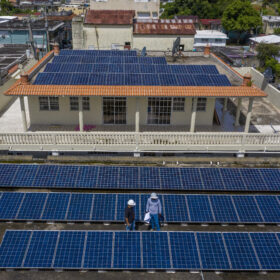Myst AI, an artificial intelligence platform for time series forecasting in electricity, just closed on its $6 million Series A round led by Valo Ventures.
According to representatives at Myst, the funding will be used to expand the company’s Forecasting as a Service (FaaS) offering.
Using data to defeat climate change
For the team at Myst, the goal has always been to mitigate the effects of climate change and find the most effective way to get a high volume of renewables not only on the grid, but generating and contributing to the grid in the most effective way possible.
“We really strongly believe that many of the biggest problems that we’re facing today as humanity can be solved, in part, by better forecasting,” Myst co-founder and CEO, Pieter Verhoeven, told pv magazine. “This is one of the reasons why we feel extremely motivated to work. At the end of the day, a lot of this comes down to demand and supply and making sure they’re in balance. Having accurate forecasting is a really critical component of making sure that’s the case.”
Myst creates precise forecasting models by combining artificial intelligence techniques with volumes of time series data from a large set of vendors, making it especially localized. Specifically, Myst helps electricity companies with near-term forecasts of electricity demand, renewable production and market prices.
“The reason why we chose to focus on electricity initially is because this is a place where accurate near-term forecasting is a critical component of the transition that we’re now in and will be in for the next ten or more years,” Myst co-founder Titiaan Palazzi said.
Learn and adapt
This focus on time series data comes from Verhoeven’s time at Nest and Google, where he helped to develop Nest’s demand response program — Rush Hour Rewards.
“The problem is that you have some historical time series datasets, which could, for example, be electricity demand,” Verhoeven told pv magazine. “Let’s say you have hourly data. Now you’re trying to create a model that can predict into the future what the hourly electricity demand will be. I had two big realizations on how to work on this problem. It doesn’t matter that much if you’re trying to forecast electricity demand or it’s forecasting how many products a company needs to have in stock, the uses cases are basically infinite for time series forecasting. The second realization that I had is that time series forecasting, as a problem, is very difficult to solve. One of the key things that makes it different from other types of use cases in machine learning is the fact that you have to deal with this notion of non-stationarity.”
Non-stationarity refers to a situation where historical data may not always be a reliable predictor of what’s going to happen in the future. With time series forecasting, you could build a model based on historical data and then, all of a sudden, an unpredictable variable throws a wrench into all your predictions. This is what happened with Covid.
The solution? More data, as much as can possibly be collected, and using that data to create highly-adaptive forecasting models.
“When the models see recent historical data, that there is a drastic shift, one that they can’t really explain, the model is going to make a consideration that maybe it not that the recent data is an anomaly, but rather that it’s a new trend kicking in,” Verhoeven explained.
“That’s a really difficult trade-off to make, because if you have two days of data being very different than the past five years, you might think of that as an anomaly. If it’s two weeks, then you start to consider that it might be a long-term trend.”
This trade-off was a difficult process for Myst to implement into its algorithms, but it was necessary to reduce prediction error.
The company touts that its models are 30-60% more accurate than other commercial solutions, which can create millions of dollars of value for its customers — an estimated 1% savings in energy procurement costs for load-serving entities like utilities and retail electric providers.
This content is protected by copyright and may not be reused. If you want to cooperate with us and would like to reuse some of our content, please contact: editors@pv-magazine.com.








It would be interesting to see how the claim “The company touts that its models are 30-60% more accurate than other commercial solutions” was substantiated. It would be nice if it was an open process.
Still, if, hypothetically, the 30%-60% cases were demonstrated on series which don’t have a lot of non-stationarity, that’s moving the goalposts a bit.